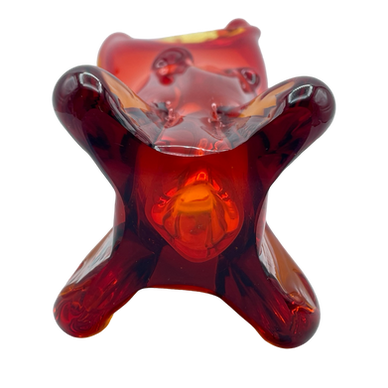Canadian Vintage Art Glass: A Strong Case for Colour, Understanding the Art of Coloured Casings
- lunasabrina

- Mar 3, 2024
- 4 min read
Updated: Aug 15, 2024
In the realm of art glass creation, a myriad of complex layers intertwine throughout the crafting process. Beginning with the initial gathering of glass, the art piece evolves progressively, embracing added colours, and undergoing various manipulations such as pulls, pinches, and stretches. As one explores deeper into the nuances of a specific glass type, its unique characteristics become more apparent. Particularly in the domain of vintage Canadian art glass, a distinctive feature is the 'casing' - the outermost layers of glass that encapsulate the vibrant hues beneath. Typically, this involves one or more layers of transparent glass. Yet, there are always intriguing deviations from the norm. This discourse explores the exceptional instances within vintage Canadian art glass from notable studios such as EDAG, Chalet, and Lorraine, where pieces are encased not in the customary clear glass but in alternative colours. These exceptional pieces often stand as the epitome of rarity and desirability within each studio's repertoire, given the relative scarcity of this technique.

The journey into this distinctive aspect of art glass often begins with a keen observation of each piece encountered. A meticulous examination of every detail - from each colour to every manipulation - can significantly enrich one's understanding and ability to make informed attributions. A reliable indicator of a piece's casing material can often be found by inspecting its base. If the 'toes', feet, or the base itself exhibits colour rather than transparency, it's indicative of a coloured casing. While occasional glimpses of clear glass may appear, particularly in areas of colour transitions, these should not be mistaken for the actual casing layer.
EDAG Crystal Glass
My exploration into this unique casing technique commenced with EDAG glass, sparked by an aqua-coloured basket that, intriguingly, exhibited a yellowish clear casing. Initially attributing this to potential additives like uranium oxide, I later ruled this out due to the absence of a glow under UV light. My thoughts then shifted to the possibility of lead inclusion, but that was quickly dismissed as EDAG glass is crafted based on the Murano cristallo formula, which is notably devoid of lead and other elements that could introduce unwanted tints. Further inquiry led to a fascinating revelation from Maestro Danilo Pavanello, who disclosed the integration of specific metals and minerals to achieve this distinctive yellow hue. This revelation shed light on EDAG's approach of utilizing a variety of coloured casings, ranging from yellow to a diverse palette that includes amber, distinct shades of blue, purple, red, and more EDAG has also cased pieces in uranium oxide leading to a very prominent glow and green-hued piece. This technique, applied at the discretion of the Maestro infuses each glass piece with a distinct character.
Lorraine Glass Industries
Lorraine Glass Industries is known for its unique approach to colour-casing, particularly with two distinct colour schemes: lime and blue, each encased in a classic salmon pink. This specialized technique seems to be exclusively applied to these specific colour variations. The resulting pieces, which range from stretches and baskets to vases, consistently feature either lime or blue hues encased in the warm salmon pink. To this point, Lorraine has not ventured beyond these colour combinations in their casings. Should a piece emerge that breaks this pattern, it would undoubtedly be considered both rare and highly sought after. Illustrated below are several examples showcasing these distinctive colour pairings.
Chalet Artistic Glass
Chalet Artistic Glass took an unconventional approach by foregoing the traditional clear casing in favor of monochromatic designs. This approach results in pieces that are uniformly one colour throughout, with occasional exceptions. For instance, in the depicted bird piece, a layer of clear glass is discernible within the tail details and pulled into the neck, nestled between layers of blue and green, hinting at a subtle interplay of colours. However, the base remains a solid green, underscoring the absence of a clear casing. Similarly, the peach pink stretch or the two blue pieces showcased below are entirely consistent in colour, lacking any clear glass overlay. It is important to distinguish that some pieces of Chalet glass have a yellow, green or grey-hues in the clear glass however this is not due to colour but rather the presence of lead oxide. Chalet glass contains 24% lead making it lead crystal vs crystal glass and this amount of lead if unbalanced can lead to unwanted hues. While it is true that Chalet had experimented with differently coloured casings, such instances are exceptionally rare, underscoring the technique's limited application within this studio. To date the only colour combination showing a coloured casing are amber pieces encased in a light blue, below is an ashtray and a twist vase example of this combination however it has also been seen in a gondola.
I encourage you all to read the following link on lead glass it is filled with fascinating information regarding the content, safety and even melting point and density. Although this is a Wikipedia link as always with Wikipedia it is important to check where the material was referenced from and in this case all information is sourced from legitimate scientific works. https://en.wikipedia.org/wiki/Lead_glass

This exploration into the nuanced world of art glass casing not only enriches our appreciation for these masterpieces but also invites us to continually scrutinize and explore the depths of each piece we encounter, adding layers of understanding to our collective knowledge of this exquisite art form.
The photographs of the Chalet blue cased twist vase was contributed by Kevin Hall. The rights to publish these photographs have been duly obtained and purchased.



























































